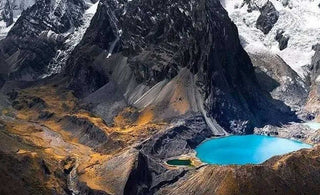
Introduction:
Nestled in the majestic folds of the Himalayas, Nepal stands as a cradle of spirituality, where ancient traditions seamlessly merge with the breathtaking landscapes. Among the myriad symbols that adorn this sacred land, none capture the essence of spiritual aspirations quite like the prayer flags. In this exploration, we unravel the intricacies of Nepal's prayer flags, focusing on their spiritual significance. Like threads weaving through the fabric of time, these flags carry profound messages, connecting the earthly and the divine.
1. Origins and Historical Roots:
The journey into the realm of Nepal's prayer flags begins with a pilgrimage through history. Originating from the Tibetan Buddhist traditions, the practice of hanging prayer flags found its way into the cultural landscape of Nepal through trade routes and cultural exchanges. The historical roots of these flags are intertwined with the spread of Buddhism across the Himalayan region, evolving over centuries to become a symbol of spiritual expression.
2. Evolution of Design and Symbolism:
As we trace the evolution of the prayer flag's design, we uncover a rich tapestry of symbolism. Traditionally, Nepal's prayer flags are characterized by five elemental colors—blue, white, red, green, and yellow. Each color carries symbolic representations, with blue signifying the sky, white representing air, red embodying fire, green symbolizing water, and yellow standing for earth. The flags are adorned with sacred images, symbols, and mantras, evolving over time to incorporate both traditional motifs and contemporary expressions.
Unlike traditional prayer flags, Confession Prayer Flags are distinguished by specific design elements that reflect the theme of self-reflection and confession. The colors, while retaining their elemental significance, may take on a subdued palette to evoke a sense of humility and inner contemplation. The imagery woven into the fabric often includes symbols representing self-awareness, transformation, and the courage to confront one's shortcomings.
3. Cultural Context:
To truly understand the spiritual significance of Nepal's prayer flags, one must delve into the cultural context that shapes their existence. These flags are not mere adornments but sacred tools believed to harmonize the elements of nature. The cultural context involves rituals, ceremonies, and a deep connection to the principles of Buddhism. The flags serve as a visual representation of the interconnectedness of all things and the pursuit of balance and harmony in life.
Confession Prayer Flags find a sacred abode in meditation spaces, where seekers embark on inner journeys. The flags, carefully hung in these spaces, serve as focal points for contemplation and self-reflection. The subtle rustling of the flags in the stillness of meditation creates an atmosphere conducive to inner exploration: a gentle reminder of the transformative power inherent in acknowledging one's vulnerabilities.
The act of hanging prayer flags is not a casual endeavor; it is a sacred ritual embedded in the cultural practices of the Himalayan communities. Before they flutter in the mountain breeze, the flags undergo a ceremony where they are imbued with prayers and blessings. This ritual is not just a tradition; it is a spiritual act believed to invoke divine intervention. The flags become conduits for positive energy, carrying prayers to the heavens and blessing the surrounding environment.
4. Symbolism of Enlightenment:
At the heart of Nepal's prayer flags lies a profound symbolism of enlightenment. The flags are not only expressions of religious devotion but also symbols of the journey towards spiritual awakening. The images and mantras woven into the fabric are designed to uplift the soul, providing a constant reminder of the path to enlightenment. Whether fluttering in the breeze or hanging in meditation spaces, these flags become portals to a higher state of consciousness.
Before a Confession Prayer Flag graces the mountain breeze, it undergoes a ritual of intention-setting. Devotees imbue the flags with personal confessions, aspirations for growth, and a commitment to overcoming obstacles. This act of intention-setting transforms the flags into vessels of personal journey, infusing them with the energy of sincere introspection. The flags, in essence, become mirrors reflecting the soul's desire for enlightenment.
While the act of confession is deeply personal, Confession Prayer Flags also carry a communal dimension. In certain traditions, communities come together to collectively hang flags, fostering a sense of shared humanity and mutual support on the path to enlightenment. The collective energy generated by these shared confessions amplifies the transformative power of the flags.
5. Contemporary Resonance and Global Appeal:
In the contemporary world, the spiritual significance of Nepal's prayer flags transcends geographical boundaries. No longer confined to the Himalayan region, these flags have found a global appeal, resonating with individuals seeking spiritual connection and inner peace. Beyond their religious connotations, the flags have become symbols of mindfulness, unity, and environmental consciousness, making them a ubiquitous presence in diverse cultural and spiritual settings.
In a world where spiritual seekers span the globe, the concept of Confession Prayer Flags transcends cultural boundaries. Modern interpretations of these flags incorporate diverse spiritual practices and therapeutic approaches, aligning with the universal human experience of growth and self-discovery. The flags have found resonance in mindfulness communities, therapy spaces, and even secular settings, offering a visual and tangible tool for introspection.
Conclusion:
In the intricate threads of Nepal's prayer flags, we find a tapestry woven with spirituality, history, and cultural richness. Each fluttering flag tells a story—a story of ancient traditions, deep-rooted beliefs, and the unending quest for enlightenment. As we navigate the spiritual significance of these flags, we realize that they are not just colorful pieces of cloth; they are pathways to the divine, threads that connect us to a higher realm of consciousness. In a world often tumultuous and chaotic, the prayer flags of Nepal stand as beacons of serenity, inviting us to embark on our own journey of enlightenment.
























